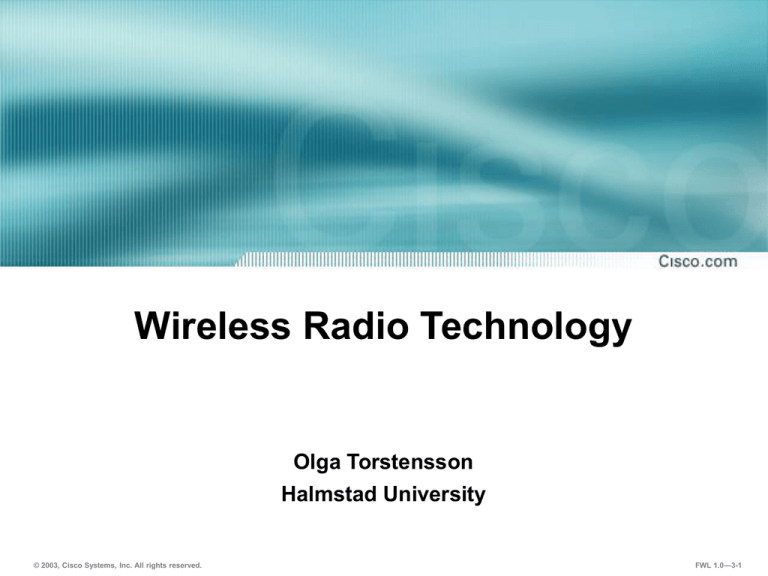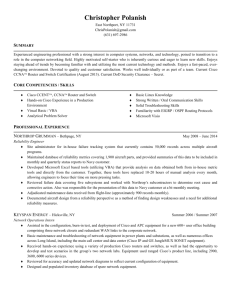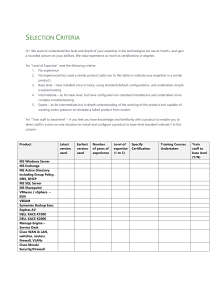
Wireless Radio Technology
Olga Torstensson
Halmstad University
© 2003, Cisco Systems, Inc. All rights reserved.
FWL 1.0—3-1
Key terms
•
•
•
•
•
•
•
•
•
•
•
© 2003, Cisco Systems, Inc. All rights reserved.
Wave
Watt
Decibel
Frequency
BPSK
CCK
OFDM
CSMA/CA
RTS
CTS
PCF
FWL 1.0—3-2
Wave Definition
© 2003, Cisco Systems, Inc. All rights reserved.
FWL 1.0—3-3
Key Terms
Amplitude — The distance from zero to the maximum value of
each alternation is called the amplitude. The amplitude of the
positive alternation and the amplitude of the negative
alternation are the same.
Period — The time it takes for a sine wave to complete one
cycle is defined as the period of the waveform. The distance
traveled by the sine wave during this period is referred to as its
wavelength.
Wavelength — Wavelength, indicated by the Greek lambda
symbol λ, is the distance along the waveform from one point to
the same point on the next cycle.
Frequency — The number of repetitions or cycles per unit time
is the frequency, typically expressed in cycles per second, or
Hz
© 2003, Cisco Systems, Inc. All rights reserved.
FWL 1.0—3-4
Frequency vs. Time Calculation
The inverse relationship between time (t),
the period in seconds, and frequency (f), in
Hz, is indicated by the following formulas:
t = 1/f
f = 1/t
© 2003, Cisco Systems, Inc. All rights reserved.
FWL 1.0—3-5
Sine Wave
© 2003, Cisco Systems, Inc. All rights reserved.
FWL 1.0—3-6
Watt
A watt is the basic unit of power, and power is related to
energy. However, power is a rate, and energy is a quantity. The
formula for power is
P = DE / Dt
DE is the amount of energy transferred (in Joules)
Dt is the time interval over which that energy is transferred.
Example: One Joule of energy is transferred in one second,
this is one watt (W) of power
© 2003, Cisco Systems, Inc. All rights reserved.
FWL 1.0—3-7
Calculating dB
The formula for calculating dB is as follows:
dB = 10 log10 (Pfinal/Pref)
dB = The amount of decibels. This usually represents a loss in
power, as the wave travels or interacts with matter, but it can
also represent a gain, as when traveling through an amplifier.
Pfinal = The final power. This is the delivered power after some
process has occurred.
Pref = The reference power. This is the original power.
© 2003, Cisco Systems, Inc. All rights reserved.
FWL 1.0—3-8
Decibel Reference
• dB milliWatt (dBm) —unit of measurement for signal strength or
power level.
• dB dipole (dBd) —the gain an antenna has, as compared to a
dipole antenna at the same frequency. A dipole antenna is the
smallest, least gain practical antenna that can be made.
• dB isotropic (dBi) —the gain a given antenna has, as compared
to a theoretical isotropic, or point source, antenna.
• Effective Isotropic Radiated Power (EIRP) —the effective power
found in the main lobe of a transmitter antenna. It is equal to the
sum of the antenna gain, in dBi, plus the power level, in dBm, into
that antenna.
• Gain —the amount of increase in energy that an antenna appears
to add to an RF signal. Cisco Aironet wireless is standardized on
dBi to specify gain measurements. Some antennas are rated in
dBd. To convert any number from dBd to dBi, simply add 2.14 to
the dBd number.
© 2003, Cisco Systems, Inc. All rights reserved.
FWL 1.0—3-9
Frequency vs. Wavelength
© 2003, Cisco Systems, Inc. All rights reserved.
FWL 1.0—3-10
EM Spectrum
© 2003, Cisco Systems, Inc. All rights reserved.
FWL 1.0—3-11
Fourier Synthesis
• When two EM waves occupy the same space,
their effects combine to form a new wave of a
different shape.
• A special sum of sine waves, of harmonically
related frequencies, could be added together to
create any wave pattern. Harmonically related
frequencies are simply frequencies that are
multiples of some basic frequency. Complex
waves can be built out of simple waves.
•The sum is called a Fourier Series
© 2003, Cisco Systems, Inc. All rights reserved.
FWL 1.0—3-12
Unlicensed Frequency Band
© 2003, Cisco Systems, Inc. All rights reserved.
FWL 1.0—3-13
Frequency and time
© 2003, Cisco Systems, Inc. All rights reserved.
FWL 1.0—3-14
Digital Signals in Time
© 2003, Cisco Systems, Inc. All rights reserved.
FWL 1.0—3-15
Carrier frequency
A carrier frequency is an electronic wave
that is combined with the information signal
and carries it across the communications
channel.
© 2003, Cisco Systems, Inc. All rights reserved.
FWL 1.0—3-16
Modulation Aspects and Techniques
There are three aspects of the basic carrier wave that can be
modulated:
– Amplitude
– Frequency
– Phase or angle
The three corresponding techniques are as follows:
– Amplitude modulation (AM)
– Frequency modulation (FM)
– Phase modulation (PM)
Other modulation techniques
–
–
–
Amplitude shift keying (ASK) — Turning the amplitude all the
way off
Frequency shift keying (FSK) — Hopping to an extreme
frequency
Phase shift keying (PSK) — Shifting the phase 180 degrees
© 2003, Cisco Systems, Inc. All rights reserved.
FWL 1.0—3-17
Binary Phase Shift Key Modulation
© 2003, Cisco Systems, Inc. All rights reserved.
FWL 1.0—3-18
FHSS
FHSS is a spread spectrum
technique that uses
frequency agility to spread
data over more than 83 MHz
of spectrum. Frequency
agility is the ability of a radio
to change transmission
frequency quickly, within the
useable RF frequency band.
© 2003, Cisco Systems, Inc. All rights reserved.
FWL 1.0—3-19
DSSS
DSSS uses a wide frequency
range of 22 MHz all of the time.
The signal is spread out across
the different frequencies. Each
data bit becomes a chipping
sequence, or a string of chips
that are transmitted in parallel,
across the frequency range. This
is sometimes referred to as the
chipping code.
Regulating agencies set a
minimum chipping rate for the
different supported speeds. IEEE
802.11 uses 11 chips. For
example, the minimum chip rate
for 802.11 DSSS, per the FCC, is
ten chips for 1 and 2 Mbps
(BPSK/QPSK) and eight chips for
11 Mbps (CCK).
© 2003, Cisco Systems, Inc. All rights reserved.
FWL 1.0—3-20
802.11b
802.11b uses three different types of modulation, depending upon the
data rate used:
•Binary phase shift keyed (BPSK) — BPSK uses one phase to
represent a binary 1 and another to represent a binary 0, for a total of
one bit of binary data. This is utilized to transmit data at 1 Mbps.
•Quadrature phase shift keying (QPSK) — With QPSK, the carrier
undergoes four changes in phase and can thus represent two binary
bits of data. This is utilized to transmit data at 2 Mbps.
•Complementary code keying (CCK) — CCK uses a complex set of
functions known as complementary codes to send more data. One of
the advantages of CCK over similar modulation techniques is that it
suffers less from multipath distortion. Multipath distortion will be
discussed later. CCK is utilized to transmit data at 5.5 Mbps and 11
Mbps.
© 2003, Cisco Systems, Inc. All rights reserved.
FWL 1.0—3-21
802.11b Channels—FCC
© 2003, Cisco Systems, Inc. All rights reserved.
FWL 1.0—3-22
Chipping Code
© 2003, Cisco Systems, Inc. All rights reserved.
FWL 1.0—3-23
OFDM
© 2003, Cisco Systems, Inc. All rights reserved.
FWL 1.0—3-24
OFDM Modulation and Data Rates
© 2003, Cisco Systems, Inc. All rights reserved.
FWL 1.0—3-25
Multiple Access Technologies
•Time Division Multiple Access (TDMA) — Each device can use
the entire available spectrum in the cell, but only for a short
period of time.
•Frequency Division Multiple Access (FDMA) — Each device
can use a portion of the available spectrum, for as long as the
device needs to, while in the cell.
•Code Division Multiple Access (CDMA) — This technique is
really a combination of the previous two. This is the most
advanced scheme and the one that is leading to Third
Generation (3G) mobile wireless technologies.
© 2003, Cisco Systems, Inc. All rights reserved.
FWL 1.0—3-26
CSMA/CA
© 2003, Cisco Systems, Inc. All rights reserved.
FWL 1.0—3-27
Application Bandwidth Needs
© 2003, Cisco Systems, Inc. All rights reserved.
FWL 1.0—3-28
RF Phenomena
When RF travels through transparent matter, some
of the waves are altered. Therefore, the velocity of
2.4 GHz and 5 GHz microwaves also changes, as
the waves travel through matter. However, the
amount of alteration depends heavily on the
frequency of the waves and the matter.
Some of the phenomena that can affect WLAN
radio waves as they travel through matter include
refraction, reflection, diffraction, scattering, and
multipath.
© 2003, Cisco Systems, Inc. All rights reserved.
FWL 1.0—3-29
Refraction
© 2003, Cisco Systems, Inc. All rights reserved.
FWL 1.0—3-30
Reflection
© 2003, Cisco Systems, Inc. All rights reserved.
FWL 1.0—3-31
Diffraction and Scattering
• The spreading out of a wave around an obstacle is
called diffraction
• When light hits small particles a phenomenon called
scattering is possible
© 2003, Cisco Systems, Inc. All rights reserved.
FWL 1.0—3-32
Multipath Distortion
Occurs when an RF
signal has more than
one path between a
receiver and a
transmitter
RF take more than one
path
Multiple signals cause
distortion of the signal
Can cause high signal
strength yet low signal
quality
© 2003, Cisco Systems, Inc. All rights reserved.
Ceiling
TX
RX
Obstruction
Floor
Received Signals
Time
Combined Results
Time
FWL 1.0—3-33
Free Space Loss
© 2003, Cisco Systems, Inc. All rights reserved.
FWL 1.0—3-34




